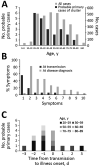Clusters of Coronavirus Disease in Communities, Japan, January-April 2020
- PMID: 32521222
- PMCID: PMC7454082
- DOI: 10.3201/eid2609.202272
Clusters of Coronavirus Disease in Communities, Japan, January-April 2020
Abstract
We analyzed 3,184 cases of coronavirus disease in Japan and identified 61 case-clusters in healthcare and other care facilities, restaurants and bars, workplaces, and music events. We also identified 22 probable primary case-patients for the clusters; most were 20-39 years of age and presymptomatic or asymptomatic at virus transmission.
Keywords: 2019 novel coronavirus disease; COVID-19; Japan; SARS; SARS-CoV-2; coronavirus; epidemiology; respiratory infections; severe acute respiratory syndrome coronavirus 2; transmission; viruses; zoonoses.
Figures


References
-
- World Health Organization. WHO Director-General’s opening remarks at the mission briefing on COVID-19—11 March 2020. [cited 2020 Jun 6]. https://www.who.int/dg/speeches/detail/who-director-general-s-opening-re...
-
- World Health Organization. WHO Director-General’s opening remarks at the mission briefing on COVID-19—26 February 2020. [cited 2020 May 3]. https://www.who.int/dg/speeches/detail/who-director-general-s-opening-re...
-
- Pung R, Chiew CJ, Young BE, Chin S, Chen MI, Clapham HE, et al.; Singapore 2019 Novel Coronavirus Outbreak Research Team. Investigation of three clusters of COVID-19 in Singapore: implications for surveillance and response measures. Lancet. 2020;395:1039–46. 10.1016/S0140-6736(20)30528-6 - DOI - PMC - PubMed
Publication types
MeSH terms
LinkOut - more resources
Full Text Sources
Miscellaneous

